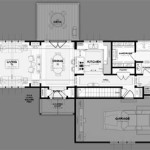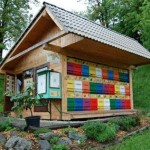Plan of a Roman Bath House
Roman bath houses, known as thermae, were an integral part of Roman society, serving not only as places for hygiene but also as social hubs, centers for exercise, and venues for relaxation and entertainment. The design and layout of these bath houses were carefully planned to provide a structured and enjoyable bathing experience. This article will delve into the typical plan of a Roman bath house, highlighting key components and their functions.
Entrance and Apodyterium
Typically, Roman bath houses were grand structures with a central entrance hall, often adorned with mosaics and statues, that led to the apodyterium. The apodyterium was a changing room where bathers would undress and store their belongings. It usually featured benches, niches, and sometimes even a small pool of cold water for footwashing. This room served as a buffer zone between the outside world and the heated bathing areas.
Calidarium, Tepidarium, and Frigidarium
The core of the Roman bath house was a series of three bathing rooms, each designed for different temperatures and purposes. The calidarium, the hottest room, featured a large pool of hot water, often heated by a hypocaust system, which circulated hot air beneath the floor and walls. This room was meant for intense heat and sweating, believed to be beneficial for health and relaxation. The tepidarium, as its name suggests, was a room of warm water, with a temperature considered comfortable for prolonged soaking. The frigidarium was the coldest room, typically featuring a plunge pool of cold water. This room was used for cooling down after the hot baths and invigorating the body. The sequence of bathing in these rooms, moving from hot to warm to cold, was intended as a therapeutic and cleansing experience.
Exercise and Recreation
Beyond the bathing areas, Roman bath houses often included spaces for other activities. A palaestra, an open-air courtyard, was common, where people could engage in exercise, wrestling, or ball games. Some bath houses also featured libraries, gardens, and even shops. These features further emphasized the social and recreational aspects of the bath house, transforming it into a multi-functional community center.
Public and Private Bath Houses
While the fundamental plan remained similar, there were variations depending on the size and function of the bath houses. Public bath houses, intended for the general populace, were often grand and elaborate, boasting impressive architectural features and expansive facilities. Smaller, private bath houses were generally attached to wealthy homes and catered to the needs of their owners and guests. These private baths might be more intimate and less elaborate but still followed the core principles of the classical Roman bath experience.
Architectural Innovations
The design and construction of Roman bath houses showcased the impressive engineering and architectural capabilities of the time. The hypocaust heating system, utilizing a network of flues and chambers to distribute heat, was a major advancement, allowing for efficient and consistent heating of the bath areas. The use of concrete and vaulting techniques enabled the construction of large, spacious bathing rooms, often adorned with intricate mosaics and frescoes. The bath houses became a testament to Roman ingenuity and their dedication to creating an environment for well-being and social interaction.
Concluding Note
The plan of a Roman bath house was a testament to the sophisticated understanding of hygiene, health, and social interaction in Roman society. The careful arrangement of different bathing spaces, along with the inclusion of recreational facilities, provided a comprehensive experience that was at once therapeutic, invigorating, and socially enriching. The Roman bath house remained a significant part of Roman life for centuries, and its influence can still be seen in modern bathhouses and spas, reminding us of the enduring legacy of Roman civilization.

The Roman Baths

Thermae Wikipedia

Roman Baths

Roman Bath House At Chesters

View Page Baths Bathing As An Ancient Roman

Roman Baths Artwork Stock Image C017 7251 Science Photo Library

General Information About Roman Baths

General Information About Roman Baths

Roman Bathhouse Layout Bath House Baths Floor Plans

Ancient Roman Baths Thermae Of Caracalla Diocletian Trajan Crystalinks








